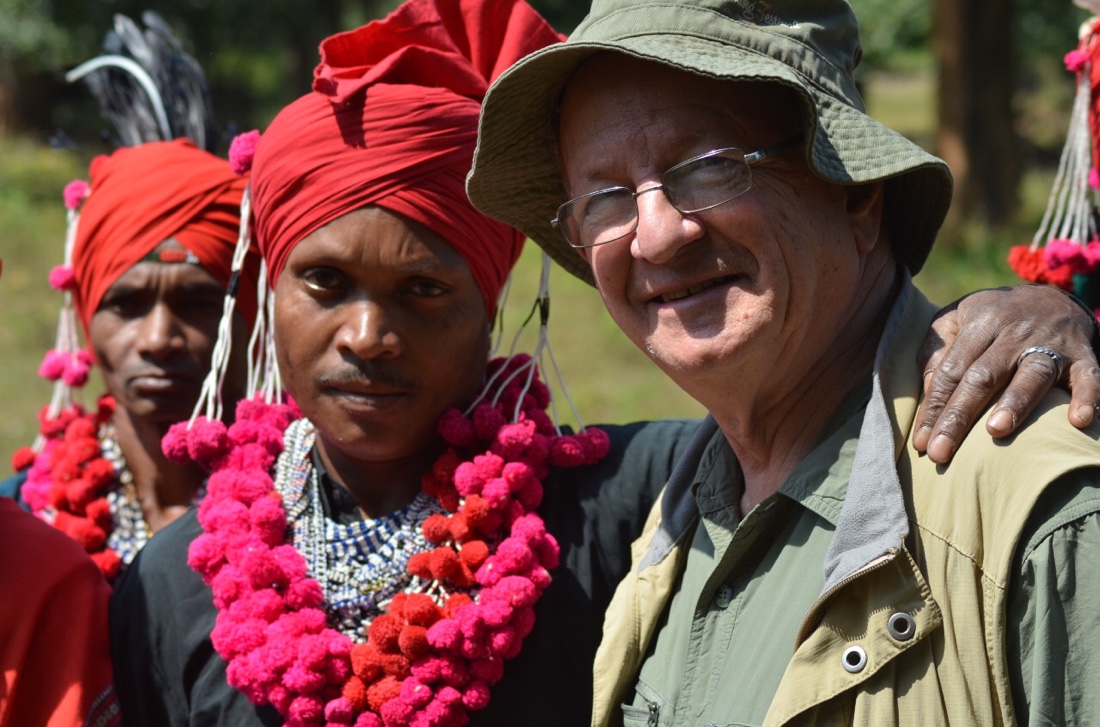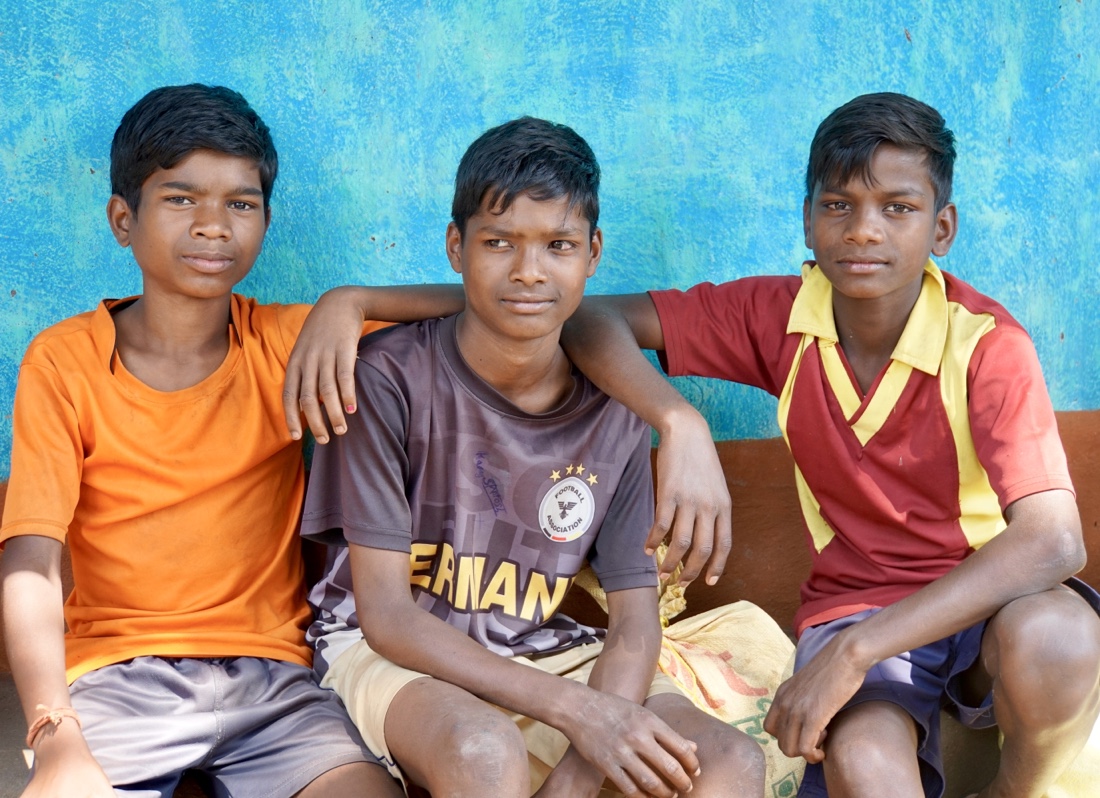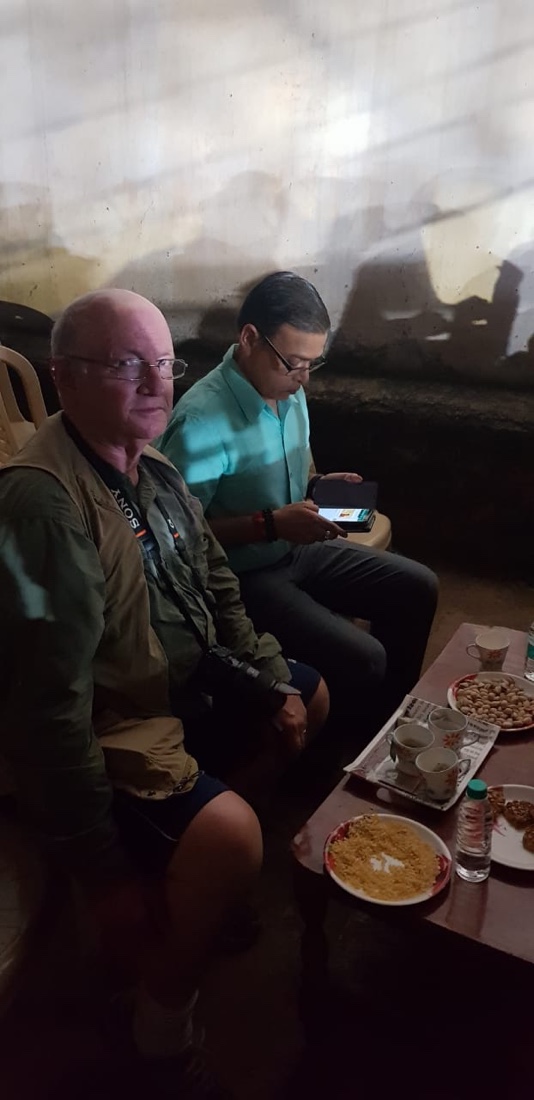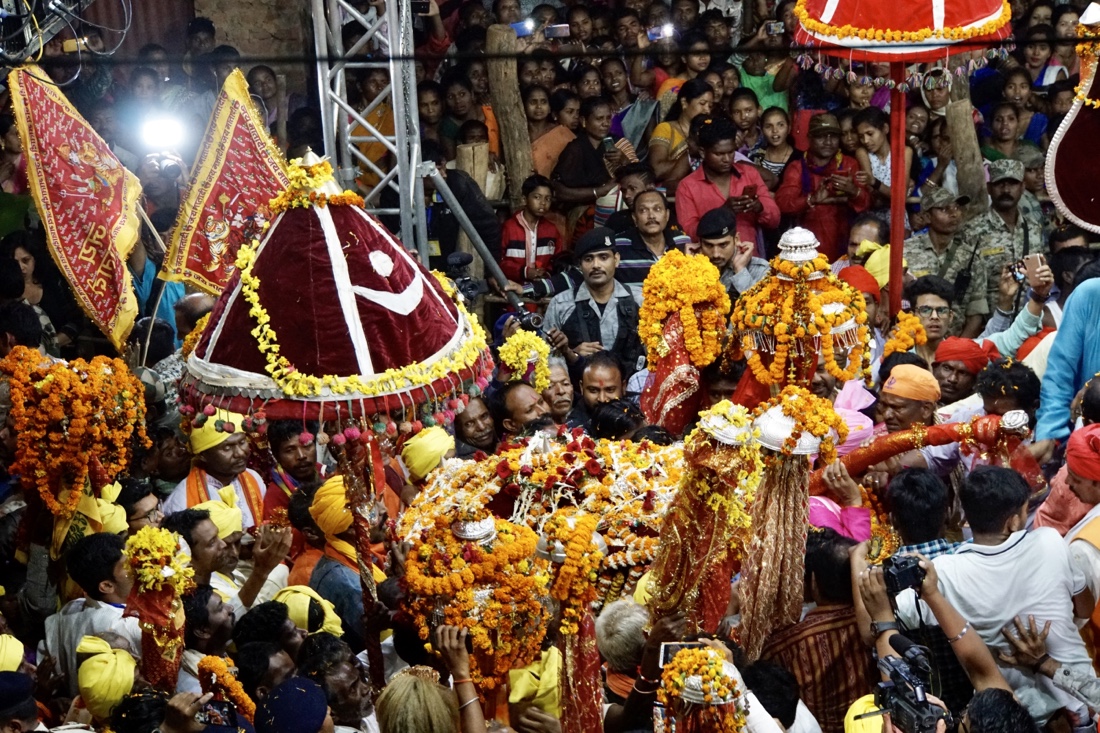October 18
Up for breakfast at 7, lovely morning with birds chirping and greenery all around. Two English women are the only other guests and, apparently, I’ll be visiting a village with them this morning. Jaspreet arrives for breakfast, and we set out around 8AM, for what promises to be an interesting, but long day.
The blog posting is working again, which improves my disposition significantly. After exchanging many emails and trying many complex operations with my guru in the US, Glenn, ultimately the problem was with the Wi-Fi connection. So once I connected to Jaspreet’s phone, I was able to post. It’s rather ridiculous that the functioning of this damn blog seems so important, but there you have it. I had resigned myself to not posting until after I got back from India, but once I did that, the universe fixed everything. I told Jaspreet that I was going to begin calling him “the universe.”
We drove about two hours to a remote Muria village. There’s an election coming up next month in India, so wherever we’ve driven we’ve seen hordes of security forces , appearing to me like army members in their uniforms.
Two British ladies who are staying at the same place I am, travel to the same village in a separate car with their guide. At first, they did not seem to be particularly friendly or communicative, but as the day, and particularly the evening wore on, they became much friendlier. Sarah and Felicity have traveled to India many many times. They come together twice a year and travel to different parts of the country. Sarah used to be in the textile business and would come here to find master craftsman doing their work. She said that that kind of work has virtually disappeared, being replaced by more mechanical and artificial products. Sarah and Felicity travel to different parts of India together twice a year now.
Arriving at the village, we are greeted by the chief, and curious villagers appear. The Muria have mixed-sex dormitories (ghotul) where adolescents are sent to sing, dance, eat, and practice premarital sex, sometimes with a single partner but more often serially. Every male member, called chelik, and girl, called motiari, takes on a new name once he or she starts going to the ghotul. They are free to choose a partner, but partners have to be changed after a maximum of seven nights of togetherness. It is thought that this is meant to discourage jealousy and instill a sense of community.
The villagers are going to perform some dances for us, so both men and women disappear and dress for the dance. We go out into the field to a shady area and watch the dances, which are interesting and fun to watch. One of the dances includes three men, who dance on stilts. We are told that these are dances that they do every night, but frankly this seems incredible to me, and I do not believe it.














 So far, the visits I’ve made to two villages have not given me much of a sense of the lives of the villagers. I have not been able to witness it, and I am hoping that the village that I go to tomorrow permits more of that.
So far, the visits I’ve made to two villages have not given me much of a sense of the lives of the villagers. I have not been able to witness it, and I am hoping that the village that I go to tomorrow permits more of that.
There are periodic roadblocks and inspections along the roads wherever we drive, which apparently are heightened somewhat because of the upcoming elections. At one of the stops on the way back from the village, we encountered a guard with a rather exaggerated view of his authority. He asked to see our visas, which we produced. I stayed in the car as did the two British women, but Jaspreet got into rather heated conversation with the guards, finally succeeding in convincing them that they should permit us to pass.
I return to the lodge for a brief, one hour rest stop, then we head into Jadalpur, which is some 20 minutes from the lodge for the greeting by the king of the arriving goddess. This is a major event and attracts a huge crowd, so we get there a couple hours before the festivities are to begin.
The Bastar Dussehra is a very unique festival that lasts 75 days, reaching an awe-inspiring crescendo in the last ten days. I am there at the apex of this crescendo. Tribes from remote areas base themselves in Jagdalpur in temporary camps in order to participate in the festival.
Introduction
Bastar Dushera owes its origin to Chalukya Maharaja Purushottam Deo Kakatiya who ruled over Bastar in the XV century. He is believed to have once walked in penance from Bastar to the Jagannath temple in Puri! He returned as ‘Rath-pati’ with a divine sanction to mount a chariot. The festival, thus, is over 500 years old.
Though the origin of the festival was Hindu in nature, it soon assimilated many elements of the local primitive tribes. The festival thus has acquired a distinct aboriginal character. Dushera, more than anything else, is symbolic of the composite character of the state in Bastar, where the Hindu kings did not impose upon their tribal subjects their ‘superior’ culture: instead, they assimilated worthy elements from the culture of various tribes and evolved a unique, local amalgam.
Description of the Bastar Dushera
• Bastar is in Dandakarnya, where Rama is believed to have spent the 14 years of his exile. Yet the Dushera here has nothing to do with Rama or Ramayana, as in most parts of the world.
• Beginning with the dark moon (amavasya) in the month of Shravan, Bastar Dushera spans over 75 days, ending on the thirteenth day of the bright moon in the month of Ashwin. It is thus the longest Dushera in the world.
• Bastar Dushera is devoted to Danteshwari, the family deity of the Kakatiya dynasty. For 10 days, the king (as the high-priest of Danteshwari) temporarily abdicated his kingly office and attended full-time to the worship of Danteshwari. During Dushera, the king, inter alia, sought, in due confidence, through a siraha (a possessed, primitive medium of the devi) intelligence report on the state.
• Bastar Dushera involves the participation of diverse tribes and castes, high and low, who constituted the praja here. Each group has a special, specific task assigned to it. These groups continue to do their age-old tasks even after kingship ended over five decades back! E.g., To build the two-tiered chariot, carpenters come from Beda Umargaon village; the special, massive ropes are twined by the tribals of Karanji, Kesarpal and Sonabal villages; the smaller chariot is pulled by the youth of Kachorapati and Agarwara parganas; the larger chariot is pulled by the bison-horn marias of Killepal. Singing hymns at all rituals is the prerogative of mundas from Potanar village.
• The chariot looks very primitive to an outsider. Nothing could have barred the king from buying a sophisticated chariot from elsewhere. But he chose to patronize the native people. The tribals, bound by their inscrutable taboos, do not employ refined tools in the making of the chariot. The massive vehicle, made new every year, is hewed into shape. The swaying juggernaut, when it is pulled by 400-plus strong marias, impresses upon an onlooker the force of aboriginal faith.
• The festival involves a congregation of hundreds of local deities enshrined in hamlets and villages across the erstwhile state of Bastar. The priests of these diverse chapels and temples even today walk in groups to Jagdalpur bearing their deities decked in flowers and their villagers sounding bells and tabors.
• The festival involves rituals of extraordinary rigor like a lass (kumari) swinging on a bed of thorns; a youth (jogi) sitting in vigil, shoulder-deep buried, for nine days; possessed mediums of local deities dancing eerily on the roads; etc
• The festival provides an occasion when elected representatives of the day, administrators and old-time tribal chieftains formally confer at the Muria Durbar on the state of Bastar.
• Bastar Dushera has so completely captured the imagination of the subjects here that the tribals have woven interesting folk songs and proverbs around Bastar Dushera!
The events take place on the streets of Jagdalpur and because of the huge rush and frenzy, the local administration cordons off the major streets. And it is virtually impossible to take good pictures from ground level. So we will climb up to a great vantage point that Jaspreet has secured for us, arriving at 6PM, before the streets get blocked. We stay put and wait for the event to take place about two and a half hours later, which we can view from the our privileged vantage point.
Coming to this area, I had been warned by several people that it was changing and would not remain the way it was for long. We have an immediate sense of this, as we look out on the street. The festival now has an event planner who has imported multicolored lights that move up-and-down, creating circles on the street. A couple of large screens have been set up down the street, so that people who cannot get close to the main platform on which the activities take place are able to view what’s happening on the platform from the street. A drone hovers above the main platform, taking photos. It all has a disappointing, commercial feel to it.
Gradually, a huge crowd gathers. Our vantage point is to be shared with some VIPs, and security forces are shouting instructions from the street up to a force member who is in our viewing area. I am very concerned that we are going to have to vacate the position we have held for more than two hours to permit these VIPs to view the festival. Shortly before the beginning of the festival, a woman stations herself to my left and begins to try to push me out of the way. I push back and Jaspreet, who is behind me, intervenes. He speaks rather heatedly to the young woman. Later, I asked Jaspreet what he had said. He said he asked her whether this is how she treats somebody who has become a very large distance to participate in and enjoy the festival. Did she not know the saying that the visitor is God? Wasn’t she ashamed of herself? After this, the woman left.
Not too long before the festivities begin, the main VIP, who is the police chief for the entire district of Bastar, arrives in our area. He is not dressed in uniform and is a relatively young man. I jokingly ask Jaspreet whether he thinks the police chief wants to have his photograph taken with me. Jaspreet takes me seriously and says he will introduce me. He introduces me as a blogger from the United States. The police chief greets me warmly and welcomes me. We shake hands. He speaks English quite well. Jaspreet asks the chief if he will have his photo taken with me and the police chief agrees readily. Fifteen minutes later a small table with tea and biscuits is set up for the police chief. The chief has somebody come over to me and invite me to sit down with him to have some tea and biscuits, which I do.

It is impossible to capture the frenzy of the festival, once it begins. All of the commercial elements fade completely into the background and one can enjoy the festival. From The palace, several blocks down to our right, my friend, the king, walks to the central stage area. He is decked out with a crown made of flowers that bloom only at the time of the festival. Down the road blocks to my left, the princess is escorted down the street to the central platform. The central platform is full of dignitaries and it is difficult even to see the king. At one point, however, he looks up at the crowd, spots me and Jaspreet and waves to us. It was the only waving that he did during the entire time. (Jaspreet can confirm thi.)
There is a frenzy of activity in motion, with tribal people from various areas trying to crash through the barriers to have their gods who they are carrying meet the princess. From the standpoint of somebody from the US, this whole spectacle is unbelievable, because there is no way anything like it would be permitted in our country because of security concerns. Below are some photos from the festival, which do not begin to do it justice.











When the festival ends and the crowd dissipates, we climb down from our vantage point and make our way back to the car. It is 10:30 by the time I get back to the lodge and instead of the that they have prepared for me I have a cold beer and some Indian breads, and then go to my room to sleep.

Arnie this is great. I love hearing about this. Seems you like to make friends with the big guys!!!
Arnie, your photos of people especially children and elderly folk are remarkable. They deserve a top award that I’m handing to you right now.
What is the average age of child birth in the Muria village
Average age at birth is less than an hour.